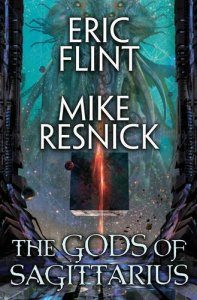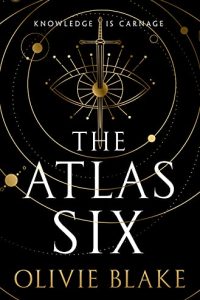Liz Bourke Reviews Velocity Weapon by Megan O’Keefe
 Velocity Weapon, Megan O’Keefe (Orbit US 978-0-356-51222-8, $15.99, 544pp, tp) June 2019.
Velocity Weapon, Megan O’Keefe (Orbit US 978-0-356-51222-8, $15.99, 544pp, tp) June 2019.
There’s really only one problem with Velocity Weapon, Megan E. O’Keefe’s first novel-length space opera, and that problem is something which ultimately isn’t a problem at all: the cover copy makes it sound like a vastly different novel than it really is, and kept me from enthusiastically devouring it for ages.
The last thing Sanda remembers is her gunship exploding…. [S]he wakes up 230 years later, on a deserted enemy starship called The Light of Berossus…. Bero tells Sanda the war is lost. That the entire star system is dead.
From the description, I conceived the mistaken belief that Velocity Weapon was a novel of science fiction horror, a book that would present a trapped, claustrophobic, single-viewpoint narrative of psychological horror and limited scope. I’ve rarely been so happy to be wrong.
This is a sweeping space opera of (it becomes clear) pretty epic proportions, with three different major viewpoint characters and nested layers of secrets, action, and intrigue. The full import of the secrets and intrigue only truly begins to come into view at the novel’s climax, promising more revelations in future volumes – for while Velocity Weapon is a satisfying book in its own right, it clearly begins a longer arc.
There are three distinct narrative strands here, of which my favourite is the first one we’re introduced to. That’s probably because Sanda is easily the character I enjoy the most, from the very first moment she wakes up aboard The Light of Berossus, deeply annoyed to find no one around, discovering that she’s missing a leg and confronted abruptly by the Light (Bero, as he prefers to be called) with the idea that she’s the only person alive in the whole star system and that the war in which she fought has been over – from mutual destruction – for centuries. The gate that would have allowed faster than light travel to a nearby star system is destroyed.
Bero was his belligerent nation’s attempt to overcome the monopoly that Prime – the polity for which Sanda fought – exercises on FTL travel. Prime controls the gates that allow near instantaneous travel between star systems. Bero’s top speed is a mere .8c. That’s enough to allow him to reach the nearest inhabited star system in sufficient time – with good care and attention – for Sanda to still be alive.
What Sanda doesn’t know (and what the reader learns alongside her) is that Bero lies. He was designed as a weapon as well as a ship of speed, but he’s a very young AI. The first deployment of his weapon traumatised him deeply, and he’s reacting with the AI version of PTSD. The star system isn’t (yet) a blasted waste, and Sanda’s family are still alive, though it’s an open question how long this state of affairs can last.
Sanda’s younger brother Biran is Velocity Weapon‘s second protagonist. He’s a Keeper, one of Prime’s ruling elite, who carries a chip implanted in his brainstem which contains part of the plans to construct one of Prime’s gates. (He becomes fairly important to the local administration of Ada-Prime, his and Sanda’s world.) Biran has a strong sense of social and personal responsibility, and – at least initially – a starry-eyed and naive view of the politics involved in his position. His desire to bring his sister – lost along with most of Ada’s fleet in a stunning defeat – home catapults him into the centre of a pit of vipers. He’s not particularly gifted at intrigue (though he learns from his mistakes) but he’s lucky enough, and talented enough, to find himself in a position of real influence. Biran’s strand of the narrative is the one which opens the political and social worldbuilding of the novel to the reader’s view, as Biran himself learns about the levers of power as he tries to learn what’s become of his sister, and as the threat from Ada’s enemies grows ever more pointed. Ultimately, Biran will risk his position and his life for his sister’s safety – even though Sanda would much rather he stay safe.
The third major viewpoint character in Velocity Weapon brings the action of the novel outside the confines of Biran and Sanda’s home system. Jules is a minor player in the criminal underworld of a world that’s Ada’s near neighbour by gate travel. Young, ambitious, and cynical (but when pressed to it, loyal to her friends), Jules stumbles into the middle of dangerous intrigue in the course of a job. What’s a minor criminal to do with a lab involving Keeper tech that doesn’t seem to have any official Keeper oversight? It appears the answer is “be hunted by the lab’s powerful and ruthless proprietors while trying to figure out what you’ve got yourself into” – some of Jules’s friends are killed or abducted, and Jules finds herself much changed by what she’s encountered. At the novel’s conclusion, we begin to see how this ties in with what’s been happening with Sanda and Biran – and see the groundwork laid for more revelations in the future.
Velocity Weapon is perfectly paced. O’Keefe unfolds her worldbuilding and her intrigue at precisely the right speed to build tension and allow for character development, and the slowly unfolding information develops mysteries that come to solid payoffs at the climax. Her prose is unobtrusive, lean, and given to occasional turns of elegance. The universe is casually, matter-of-factly queer and filled with a wide array of people and beliefs.
Where Velocity Weapon shines brightest is its characters. Sanda’s matter-of-fact sarcasm and pragmatism are deeply compelling as she negotiates relationships with people she doesn’t know if she can (afford to) trust, and her struggle to reconcile what she’s been told and what’s been done to her with her worldview is well-drawn. Biran is a little more idealistic and less worldly than his sister, and his journey scuffs all that shiny bright idealism, even if it doesn’t diminish his sense of personal responsibility – he makes personal choices that are increasingly unsustainable in his quest to bring his sister home and face up to the crisis confronting his home. Jules is easy to sympathise with, especially in her determination to seize her opportunities and in her loyalty to her friends.
This is a sweeping space opera with scope and vision, tremendously readable. I look forward to seeing where O’Keefe takes this story next.
Liz Bourke is a cranky queer person who reads books. She holds a Ph.D in Classics from Trinity College, Dublin. Her first book, Sleeping With Monsters, a collection of reviews and criticism, is out now from Aqueduct Press. Find her at her blog, her Patreon, or Twitter. She supports the work of the Irish Refugee Council and the Abortion Rights Campaign.
This review and more like it in the August 2019 issue of Locus.
 While you are here, please take a moment to support Locus with a one-time or recurring donation. We rely on reader donations to keep the magazine and site going, and would like to keep the site paywall free, but WE NEED YOUR FINANCIAL SUPPORT to continue quality coverage of the science fiction and fantasy field.
While you are here, please take a moment to support Locus with a one-time or recurring donation. We rely on reader donations to keep the magazine and site going, and would like to keep the site paywall free, but WE NEED YOUR FINANCIAL SUPPORT to continue quality coverage of the science fiction and fantasy field.






